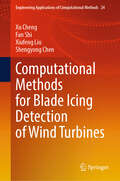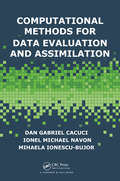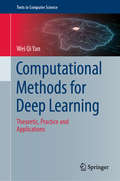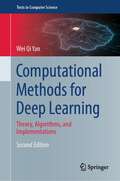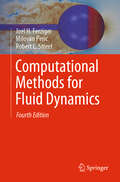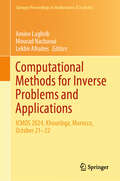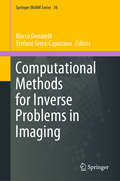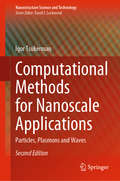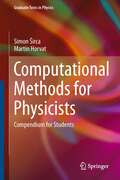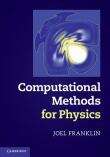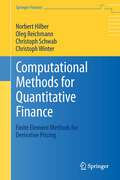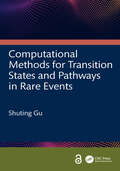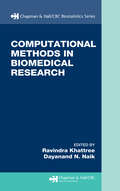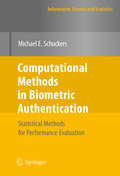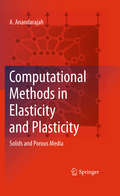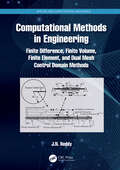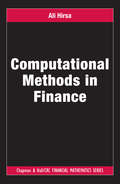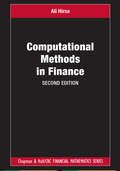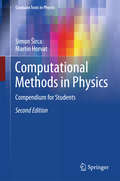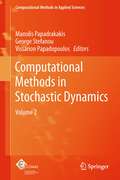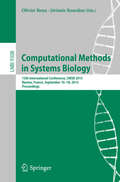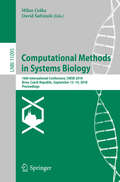- Table View
- List View
Computational Methods for Blade Icing Detection of Wind Turbines (Engineering Applications of Computational Methods #24)
by Xiufeng Liu Shengyong Chen Xu Cheng Fan ShiThis book thoroughly explores the realm of data-driven blade-icing detection for wind turbines, focusing on multivariate time series classification to enhance the reliability and efficiency of wind energy utilization. The widespread prevalence of sensor technology in wind turbines, coupled with substantial data collection, has paved the way for advanced data-driven methodologies, which do not require extensive domain knowledge or additional mechanical tools. The interdisciplinary appeal of this study has drawn attention from experts in fields like computer science, mechanical engineering, and renewable energy systems. Adopting a comprehensive approach, the book lays down a foundational framework for blade-icing detection, stressing the critical role of sensor data integration and the profound impact of machine learning techniques in refining the detection processes. The book is designed for undergraduate and graduate students keen on renewable energy technologies, researchers delving into machine learning applications in energy systems, and engineers focusing on sustainable solutions for enhancing wind turbine performance.
Computational Methods for Data Evaluation and Assimilation
by Dan Gabriel Cacuci Ionel Michael Navon Mihaela Ionescu-BujorData evaluation and data combination require the use of a wide range of probability theory concepts and tools, from deductive statistics mainly concerning frequencies and sample tallies to inductive inference for assimilating non-frequency data and a priori knowledge. Computational Methods for Data Evaluation and Assimilation presents interdiscipli
Computational Methods for Deep Learning: Theoretic, Practice and Applications (Texts in Computer Science)
by Wei Qi YanIntegrating concepts from deep learning, machine learning, and artificial neural networks, this highly unique textbook presents content progressively from easy to more complex, orienting its content about knowledge transfer from the viewpoint of machine intelligence. It adopts the methodology from graphical theory, mathematical models, and algorithmic implementation, as well as covers datasets preparation, programming, results analysis and evaluations.Beginning with a grounding about artificial neural networks with neurons and the activation functions, the work then explains the mechanism of deep learning using advanced mathematics. In particular, it emphasizes how to use TensorFlow and the latest MATLAB deep-learning toolboxes for implementing deep learning algorithms.As a prerequisite, readers should have a solid understanding especially of mathematical analysis, linear algebra, numerical analysis, optimizations, differential geometry, manifold, and information theory, as well as basic algebra, functional analysis, and graphical models. This computational knowledge will assist in comprehending the subject matter not only of this text/reference, but also in relevant deep learning journal articles and conference papers.This textbook/guide is aimed at Computer Science research students and engineers, as well as scientists interested in deep learning for theoretic research and analysis. More generally, this book is also helpful for those researchers who are interested in machine intelligence, pattern analysis, natural language processing, and machine vision.Dr. Wei Qi Yan is an Associate Professor in the Department of Computer Science at Auckland University of Technology, New Zealand. His other publications include the Springer title, Visual Cryptography for Image Processing and Security.
Computational Methods for Deep Learning: Theory, Algorithms, and Implementations (Texts in Computer Science)
by Wei Qi YanThe first edition of this textbook was published in 2021. Over the past two years, we have invested in enhancing all aspects of deep learning methods to ensure the book is comprehensive and impeccable. Taking into account feedback from our readers and audience, the author has diligently updated this book. The second edition of this textbook presents control theory, transformer models, and graph neural networks (GNN) in deep learning. We have incorporated the latest algorithmic advances and large-scale deep learning models, such as GPTs, to align with the current research trends. Through the second edition, this book showcases how computational methods in deep learning serve as a dynamic driving force in this era of artificial intelligence (AI). This book is intended for research students, engineers, as well as computer scientists with interest in computational methods in deep learning. Furthermore, it is also well-suited for researchers exploring topics such as machine intelligence, robotic control, and related areas.
Computational Methods for Fluid Dynamics
by Joel H. Ferziger Milovan Perić Robert L. StreetThis book is a guide to numerical methods for solving fluid dynamics problems. The most widely used discretization and solution methods, which are also found in most commercial CFD-programs, are described in detail. Some advanced topics, like moving grids, simulation of turbulence, computation of free-surface flows, multigrid methods and parallel computing, are also covered. Since CFD is a very broad field, we provide fundamental methods and ideas, with some illustrative examples, upon which more advanced techniques are built. Numerical accuracy and estimation of errors are important aspects and are discussed in many examples. Computer codes that include many of the methods described in the book can be obtained online. This 4th edition includes major revision of all chapters; some new methods are described and references to more recent publications with new approaches are included. Former Chapter 7 on solution of the Navier-Stokes equations has been split into two Chapters to allow for a more detailed description of several variants of the Fractional Step Method and a comparison with SIMPLE-like approaches. In Chapters 7 to 13, most examples have been replaced or recomputed, and hints regarding practical applications are made. Several new sections have been added, to cover, e.g., immersed-boundary methods, overset grids methods, fluid-structure interaction and conjugate heat transfer.
Computational Methods for Inverse Problems and Applications: ICMDS 2024, Khouribga, Morocco, October 21–22 (Springer Proceedings in Mathematics & Statistics #498)
by Amine Laghrib Lekbir Afraites Mourad NachaouiThis book highlights recent trends in inverse problems and their integration with computer science, a field rapidly evolving yet underexplored mathematically. ICMDS 2024 aims to unite scientists to explore the latest in mathematics and its applications across various scientific disciplines. Key topics include inverse problems, partial differential equations, mathematical control, numerical analysis, and computer science. Our goal is to provide substantial mathematical insights and practical applications to bridge this gap. With its growing significance in media and industry, this event promises to attract a diverse audience and foster collaboration across scientific domains. The main contribution of this book is to give some sufficient mathematical content with expressive results and accurate applications. As a growing field, it is gaining a lot of attention both in media as well as in the industry world, which will attract the interest of readers from different scientist discipline.
Computational Methods for Inverse Problems in Imaging (Springer INdAM Series #36)
by Stefano Serra-Capizzano Marco DonatelliThis book presents recent mathematical methods in the area of inverse problems in imaging with a particular focus on the computational aspects and applications. The formulation of inverse problems in imaging requires accurate mathematical modeling in order to preserve the significant features of the image. The book describes computational methods to efficiently address these problems based on new optimization algorithms for smooth and nonsmooth convex minimization, on the use of structured (numerical) linear algebra, and on multilevel techniques. It also discusses various current and challenging applications in fields such as astronomy, microscopy, and biomedical imaging. The book is intended for researchers and advanced graduate students interested in inverse problems and imaging.
Computational Methods for Nanoscale Applications: Particles, Plasmons and Waves (Nanostructure Science and Technology)
by Igor TsukermanPositioning itself at the common boundaries of several disciplines, this work provides new perspectives on modern nanoscale problems where fundamental science meets technology and computer modeling. In addition to well-known computational techniques such as finite-difference schemes and Ewald summation, the book presents a new finite-difference calculus of Flexible Local Approximation Methods (FLAME) that qualitatively improves the numerical accuracy in a variety of problems.
Computational Methods for Numerical Analysis with R (Chapman & Hall/CRC Numerical Analysis and Scientific Computing Series)
by Ii James P HowardComputational Methods for Numerical Analysis with R is an overview of traditional numerical analysis topics presented using R. This guide shows how common functions from linear algebra, interpolation, numerical integration, optimization, and differential equations can be implemented in pure R code. Every algorithm described is given with a complete function implementation in R, along with examples to demonstrate the function and its use. <P><P>Computational Methods for Numerical Analysis with R is intended for those who already know R, but are interested in learning more about how the underlying algorithms work. As such, it is suitable for statisticians, economists, and engineers, and others with a computational and numerical background.
Computational Methods for Physicists: Compendium for Students (Graduate Texts in Physics)
by Simon Sirca Martin HorvatThis book helps advanced undergraduate, graduate and postdoctoral students in their daily work by offering them a compendium of numerical methods. The choice of methods pays significant attention to error estimates, stability and convergence issues as well as to the ways to optimize program execution speeds. Many examples are given throughout the chapters, and each chapter is followed by at least a handful of more comprehensive problems which may be dealt with, for example, on a weekly basis in a one- or two-semester course. In these end-of-chapter problems the physics background is pronounced, and the main text preceding them is intended as an introduction or as a later reference. Less stress is given to the explanation of individual algorithms. It is tried to induce in the reader an own independent thinking and a certain amount of scepticism and scrutiny instead of blindly following readily available commercial tools.
Computational Methods for Physics
by Joel FranklinThere is an increasing need for undergraduate students in physics to have a core set of computational tools. Most problems in physics benefit from numerical methods, and many of them resist analytical solution altogether. This textbook presents numerical techniques for solving familiar physical problems where a complete solution is inaccessible using traditional mathematical methods. The numerical techniques for solving the problems are clearly laid out, with a focus on the logic and applicability of the method. The same problems are revisited multiple times using different numerical techniques, so readers can easily compare the methods. The book features over 250 end-of-chapter exercises. A website hosted by the author features a complete set of programs used to generate the examples and figures, which can be used as a starting point for further investigation. A link to this can be found at www. cambridge. org/9781107034303.
Computational Methods for Quantitative Finance: Finite Element Methods for Derivative Pricing (Springer Finance)
by Christoph Schwab Christoph Winter Norbert Hilber Oleg ReichmannMany mathematical assumptions on which classical derivative pricing methods are based have come under scrutiny in recent years. The present volume offers an introduction to deterministic algorithms for the fast and accurate pricing of derivative contracts in modern finance. This unified, non-Monte-Carlo computational pricing methodology is capable of handling rather general classes of stochastic market models with jumps, including, in particular, all currently used Lévy and stochastic volatility models. It allows us e.g. to quantify model risk in computed prices on plain vanilla, as well as on various types of exotic contracts. The algorithms are developed in classical Black-Scholes markets, and then extended to market models based on multiscale stochastic volatility, to Lévy, additive and certain classes of Feller processes. This book is intended for graduate students and researchers, as well as for practitioners in the fields of quantitative finance and applied and computational mathematics with a solid background in mathematics, statistics or economics.
Computational Methods for Transition States and Pathways in Rare Events
by Shuting GuBased on the calculation of transition states and the identification of transition paths, this book aims to provide a comprehensive guide to understanding and simulating rare events.The author introduces both fundamental concepts of transition states and pathways and advanced computational techniques, focusing on Gentlest Ascent Dynamics (GAD) and its variants. In particular, she explores enhanced numerical methods such as the convex splitting method and the Scalar Auxiliary Variable (SAV) approach within the Iterative Minimization Formulation (IMF). In addition, the book applies these methods to real-world problems, highlighting the string method and the geometric Minimum Action Method (gMAM) for computing transition paths.The book is written for researchers and practitioners in fields such as applied mathematics, physics, chemistry, and computational science who are interested in the underlying mechanisms of rare events and their transition processes.Chapters 3 and 4 of this book are each freely available as a downloadable Open Access PDF at http://www.taylorfrancis.com under a Creative Commons Attribution-Non Commercial-No Derivatives (CC-BY-NC-ND) 4.0 license.
Computational Methods in Biomedical Research
by Ian MuehlenhausContinuing advances in biomedical research and statistical methods call for a constant stream of updated, cohesive accounts of new developments so that the methodologies can be properly implemented in the biomedical field. Responding to this need, Computational Methods in Biomedical Research explores important current and emerging computatio
Computational Methods in Biometric Authentication: Statistical Methods for Performance Evaluation (Information Science and Statistics)
by Michael E. SchuckersBiometrics, the science of using physical traits to identify individuals, is playing an increasing role in our security-conscious society and across the globe. Biometric authentication, or bioauthentication, systems are being used to secure everything from amusement parks to bank accounts to military installations. Yet developments in this field have not been matched by an equivalent improvement in the statistical methods for evaluating these systems. Compensating for this need, this unique text/reference provides a basic statistical methodology for practitioners and testers of bioauthentication devices, supplying a set of rigorous statistical methods for evaluating biometric authentication systems. This framework of methods can be extended and generalized for a wide range of applications and tests. This is the first single resource on statistical methods for estimation and comparison of the performance of biometric authentication systems. The book focuses on six common performance metrics: for each metric, statistical methods are derived for a single system that incorporates confidence intervals, hypothesis tests, sample size calculations, power calculations and prediction intervals. These methods are also extended to allow for the statistical comparison and evaluation of multiple systems for both independent and paired data. Topics and features: * Provides a statistical methodology for the most common biometric performance metrics: failure to enroll (FTE), failure to acquire (FTA), false non-match rate (FNMR), false match rate (FMR), and receiver operating characteristic (ROC) curves * Presents methods for the comparison of two or more biometric performance metrics * Introduces a new bootstrap methodology for FMR and ROC curve estimation * Supplies more than 120 examples, using publicly available biometric data where possible * Discusses the addition of prediction intervals to the bioauthentication statistical toolset * Describes sample-size and power calculations for FTE, FTA, FNMR and FMR Researchers, managers and decisions makers needing to compare biometric systems across a variety of metrics will find within this reference an invaluable set of statistical tools. Written for an upper-level undergraduate or master's level audience with a quantitative background, readers are also expected to have an understanding of the topics in a typical undergraduate statistics course. Dr. Michael E. Schuckers is Associate Professor of Statistics at St. Lawrence University, Canton, NY, and a member of the Center for Identification Technology Research.
Computational Methods in Elasticity and Plasticity: Solids and Porous Media
by A. AnandarajahComputational Methods in Elasticity and Plasticity: Solids and Porous Media presents the latest developments in the area of elastic and elasto-plastic finite element modeling of solids, porous media and pressure-dependent materials and structures. The book covers the following topics in depth: the mathematical foundations of solid mechanics, the finite element method for solids and porous media, the theory of plasticity and the finite element implementation of elasto-plastic constitutive models. The book also includes: -A detailed coverage of elasticity for isotropic and anisotropic solids. -A detailed treatment of nonlinear iterative methods that could be used for nonlinear elastic and elasto-plastic analyses. -A detailed treatment of a kinematic hardening von Mises model that could be used to simulate cyclic behavior of solids. -Discussion of recent advances in the analysis of porous media and pressure-dependent materials in more detail than other books currently available. Computational Methods in Elasticity and Plasticity: Solids and Porous Media also contains problem sets, worked examples and a solutions manual for instructors.
Computational Methods in Engineering: Finite Difference, Finite Volume, Finite Element, and Dual Mesh Control Domain Methods (Applied and Computational Mechanics)
by J.N. ReddyComputational Methods in Engineering: Finite Difference, Finite Volume, Finite Element, and Dual Mesh Control Domain Methods provides readers with the information necessary to choose appropriate numerical methods to solve a variety of engineering problems. Explaining common numerical methods in an accessible yet rigorous manner, the book details the finite element method (FEM), finite volume method (FVM) and importantly, a new numerical approach, dual mesh control domain method (DMCDM).Numerical methods are crucial to everyday engineering. The book begins by introducing the various methods and their applications, with example problems from a range of engineering disciplines including heat transfer, solid and structural mechanics, and fluid mechanics. It highlights the strengths of FEM, with its systematic procedure and modular steps, and then goes on to explain the uses of FVM. It explains how DMCDM embodies useful parts of both FEM and FVM, particularly in its use of the control domain method and how it can provide a comprehensive computational approach. The final chapters look at ways to use different numerical methods, primarily FEM and DMCDM, to solve typical problems of bending of beams, axisymmetric circular plates, and other nonlinear problems.This book is a useful guide to numerical methods for professionals and students in all areas of engineering and engineering mathematics.
Computational Methods in Finance (Chapman and Hall/CRC Financial Mathematics Series)
by Ali HirsaHelping readers accurately price a vast array of derivatives, this self-contained text explains how to solve complex functional equations through numerical methods. It addresses key computational methods in finance, including transform techniques, the finite difference method, and Monte Carlo simulation. Developed from his courses at Columbia University and the Courant Institute of New York University, the author also covers model calibration and optimization and describes techniques, such as Kalman and particle filters, for parameter estimation.
Computational Methods in Finance (Chapman and Hall/CRC Financial Mathematics Series)
by Ali HirsaComputational Methods in Finance is a book developed from the author’s courses at Columbia University and the Courant Institute of New York University. This self-contained text is designed for graduate students in financial engineering and mathematical finance, as well as practitioners in the financial industry. It will help readers accurately price a vast array of derivatives.This new edition has been thoroughly revised throughout to bring it up to date with recent developments. It features numerous new exercises and examples, as well as two entirely new chapters on machine learning.Features Explains how to solve complex functional equations through numerical methods Includes dozens of challenging exercises Suitable as a graduate-level textbook for financial engineering and financial mathematics or as a professional resource for working quants.
Computational Methods in Physics: Compendium for Students (Graduate Texts in Physics)
by Martin Horvat Simon ŠircaThis book is intended to help advanced undergraduate, graduate, and postdoctoral students in their daily work by offering them a compendium of numerical methods. The choice of methods pays significant attention to error estimates, stability and convergence issues, as well as optimization of program execution speeds. Numerous examples are given throughout the chapters, followed by comprehensive end-of-chapter problems with a more pronounced physics background, while less stress is given to the explanation of individual algorithms. The readers are encouraged to develop a certain amount of skepticism and scrutiny instead of blindly following readily available commercial tools. The second edition has been enriched by a chapter on inverse problems dealing with the solution of integral equations, inverse Sturm-Liouville problems, as well as retrospective and recovery problems for partial differential equations. The revised text now includes an introduction to sparse matrix methods, the solution of matrix equations, and pseudospectra of matrices; it discusses the sparse Fourier, non-uniform Fourier and discrete wavelet transformations, the basics of non-linear regression and the Kolmogorov-Smirnov test; it demonstrates the key concepts in solving stiff differential equations and the asymptotics of Sturm-Liouville eigenvalues and eigenfunctions. Among other updates, it also presents the techniques of state-space reconstruction, methods to calculate the matrix exponential, generate random permutations and compute stable derivatives.
Computational Methods in Physics: Compendium for Students (Graduate Texts in Physics)
by Martin Horvat Simon ŠircaThis textbook provides a compendium of numerical methods to assist physics students and researchers in their daily work. It carefully considers error estimates, stability and convergence issues, the choice of optimal methods, and techniques to increase program execution speeds. The book supplies numerous examples throughout the chapters that are concluded by more comprehensive problems with a strong physics background. Instead of uncritically employing modern black-box tools, the readers are encouraged to develop a more ponderous and skeptical approach. This revised and expanded edition now includes a new chapter on numerical integration and stable differentiation, as well as fresh material on optimal filtering, integration of gravitational many-body problems, computation of Poincaré maps, regularization of orbits, singular Sturm-Liouville problems, techniques for time evolution and spatial treatment of (semi)infinite domains in spectral methods, and phase retrieval. It also brings updated discussions of algebraic problems involving sparse matrices and of high-resolution schemes for partial differential equations.
Computational Methods in Plasma Physics (Chapman & Hall/CRC Computational Science)
by Stephen JardinAssuming no prior knowledge of plasma physics or numerical methods, Computational Methods in Plasma Physics covers the computational mathematics and techniques needed to simulate magnetically confined plasmas in modern magnetic fusion experiments and future magnetic fusion reactors. Largely self-contained, the text presents the basic concepts neces
Computational Methods in Stochastic Dynamics: Volume 2 (Computational Methods in Applied Sciences #26)
by Manolis Papadrakakis George Stefanou Vissarion PapadopoulosThe considerable influence of inherent uncertainties on structural behavior has led the engineering community to recognize the importance of a stochastic approach to structural problems. Issues related to uncertainty quantification and its influence on the reliability of the computational models are continuously gaining in significance. In particular, the problems of dynamic response analysis and reliability assessment of structures with uncertain system and excitation parameters have been the subject of continuous research over the last two decades as a result of the increasing availability of powerful computing resources and technology. This book is a follow up of a previous book with the same subject (ISBN 978-90-481-9986-0) and focuses on advanced computational methods and software tools which can highly assist in tackling complex problems in stochastic dynamic/seismic analysis and design of structures. The selected chapters are authored by some of the most active scholars in their respective areas and represent some of the most recent developments in this field. The book consists of 21 chapters which can be grouped into several thematic topics including dynamic analysis of stochastic systems, reliability-based design, structural control and health monitoring, model updating, system identification, wave propagation in random media, seismic fragility analysis and damage assessment. This edited book is primarily intended for researchers and post-graduate students who are familiar with the fundamentals and wish to study or to advance the state of the art on a particular topic in the field of computational stochastic structural dynamics. Nevertheless, practicing engineers could benefit as well from it as most code provisions tend to incorporate probabilistic concepts in the analysis and design of structures.
Computational Methods in Systems Biology: 13th International Conference, CMSB 2015, Nantes, France, September 16-18, 2015, Proceedings (Lecture Notes in Computer Science #9308)
by Olivier Roux Jérémie BourdonThis book constitutes the refereed proceedings of the 13th International Conference on Computational Methods in Systems Biology, CMSB 2015, held in Nantes, France, in September 2015. The 20 full papers and 2 short papers presented were carefully reviewed and selected from 43 full and 4 short paper submissions. The papers cover a wide range of topics in the analysis of biological systems, networks and data such as model checking, stochastic analysis, hybrid systems, circadian clock, time series data, logic programming, and constraints solving ranging from intercellular to multiscale.
Computational Methods in Systems Biology: 16th International Conference, CMSB 2018, Brno, Czech Republic, September 12-14, 2018, Proceedings (Lecture Notes in Computer Science #11095)
by David Šafránek Milan ČeškaThis book constitutes the refereed proceedings of the 16th International Conference on Computational Methods in Systems Biology, CMSB 2018, held in BRNO, Czech Republic, in September 2018. The 15 full and 7 short papers presented together with 5 invited talks were carefully reviewed and selected from 46 submissions. Topics of interest include formalisms for modeling biological processes; models and their biological applications; frameworks for model verification, validation, analysis, and simulation of biological systems; high-performance computational systems biology; parameter and model inference from experimental data; automated parameter and model synthesis; model integration and biological databases; multi-scale modeling and analysis methods; design, analysis, and verification methods for synthetic biology; methods for biomolecular computing and engineered molecular devices.Chapters 3, 9 and 10 are available open access under a Creative Commons Attribution 4.0 International License via link.springer.com.
